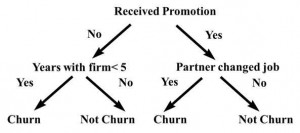By: Bart Baesens, Seppe vanden Broucke
This QA first appeared in Data Science Briefings, the DataMiningApps newsletter as a “Free Tweet Consulting Experience” — where we answer a data science or analytics question of 140 characters maximum. Also want to submit your question? Just Tweet us @DataMiningApps. Want to remain anonymous? Then send us a direct message and we’ll keep all your details private. Subscribe now for free if you want to be the first to receive our articles and stay up to data on data science news, or follow us @DataMiningApps.
You asked: Can you give some examples of HR analytics applications?
Our answer:
Various examples can be thought of to successfully leverage Big Data & Analytics in HR. A first application is analyzing employee churn, which is a major problem for many companies these days. Great talent is scarce, hard to keep and highly solicited by headhunters! Hence, given the well-known direct relationship between happy employees and happy customers, it becomes of utmost importance to keep your employees and understand the drivers of employee dissatisfaction. Big Data & Analytics can be used for this purpose. A first step to do so, is to collect historical data on employee churn. The more data, the better as this gives us more opportunities to find previously unknown, interesting insights. In a next step, the data will be consolidated, aggregated and cleaned such that it becomes ready for analysis. An analytical model can then be built to predict employee churn. The below figure shows an example of a decision tree, which is one of the most popular analytical models in use in the industry nowadays. It can be automatically constructed from a (big) data set and gives clear insight into which employees churn and which ones not.

Another interesting application of HR analytics is analyzing employee absenteeism. Employees may be absent due to illness, accidents or burn out. Especially the latter has received wide attention recently. Using Big Data & Analytics, it now becomes possible to adequately understand the drivers of employee absenteeism and act upon it before the problems start to occur.
These are just a few applications of HR analytics and many others can be thought of. Examples are: understanding workforce collaboration patterns using social network techniques, job recruitment based upon intelligent recommender systems, career path analysis using sequence rules, talent forecasting, etc.
